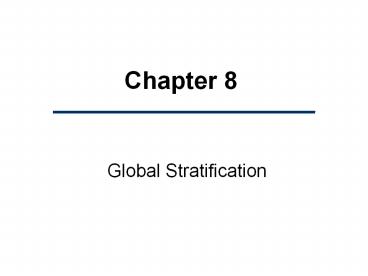Global Stratification - PowerPoint PPT Presentation
1 / 25
Title:
Global Stratification
Description:
Title: Chapter 7 Class And Stratification In The United States Author: stacy Last modified by: rcc Created Date: 8/2/2001 4:35:53 PM Document presentation format – PowerPoint PPT presentation
Number of Views:642
Avg rating:3.0/5.0
Title: Global Stratification
1
Chapter 8
- Global Stratification
2
Chapter Outline
- Wealth and Poverty in Global Perspective
- Problems in Studying Global Inequality
- Classification of Economies by Income
- Measuring Global Wealth and Poverty
3
Chapter Outline
- Global Poverty and Human Development Issues
- Theories of Global Inequality
- Global Inequality in the Future
4
Global Stratification
- The unequal distribution of wealth, power, and
prestige on a global basis, resulting in people
having vastly different lifestyles and life
chances both within and among the nations of the
world.
5
High-income Countries
- Characterized by highly industrialized economies
technologically advanced industrial,
administrative, and service occupations and high
levels of national and per capita income.
6
Middle-income Countries
- Nations with industrializing economies,
particularly in urban areas, and moderate levels
of national and personal income.
7
Low-income Countries
- Primarily agrarian nations with little
industrialization and low levels of national and
personal income.
8
Income Gap Worlds Richest and Poorest People
9
The Three Worlds Approach
- First World nations were said to consist of the
rich, industrialized nations that primarily had
capitalist economic systems and democratic
political systems. - Second World nations were said to be countries
with at least a moderate level of economic
development and a moderate standard of living. - Third World countries have little or no
industrialization and the lowest standards of
living, shortest life expectancies, and highest
rates of mortality.
10
Theories of global inequality
- Development theory A perspective that links
global inequality to different levels of economic
development and suggests that low income
countries can alleviate the worst effects of
poverty by the attempts of industrialized
nations.
11
Theories of global inequality
- Three world approach is the differences among
nations on the bases of their levels of - of economic development and the standard
living of their citizen. - Gross national income and gross domestic
- product.
- Rate of population living in the ninety three
nation with middle income countries
12
Levels of Development Approach
- Among the most controversial terminology for
describing world poverty and global
stratification. - Terminology based on levels of development
includes concepts such as developed nations,
developing nations, less developed nations, and
underdevelopment.
13
World Bank Classification of Economies by Income
- The World Bank classifies nations into three
economic categories - low-income economies (a GNI per capita of 765 or
less in 2003) - middle-income economies (a GNI per capita between
766 and 9,385 in 2003) - high-income economies (a GNI per capita of more
than 9,385 in 2003).
14
Economies in Global Perspective
15
Gross Domestic Product (GDP)
- All the goods and services produced within a
countrys economy during a given year. - The GDP does not include any income earned by
individuals or corporations if the revenue comes
from sources outside of the country.
16
Global Poverty
- Absolute poverty would be measured by comparing
personal or household income or expenses with the
cost of buying a given quantity of goods and
services. - Relative poverty exists when people may be able
to afford basic necessities but are still unable
to maintain an average standard of living. - Subjective poverty would be measured by comparing
the actual income against the income earners
expectations and perceptions.
17
Dimensions of Defining Levels of Poverty
- How many people are poor.
- How far below the poverty line peoples incomes
fall. - How long they have been poor (is the poverty
temporary or long term?.
18
Gini Coefficeient
- A measure of income inequality which ranges from
zero (meaning that everyone has the same income)
to 100 (one person receives all the income). - Using this measure, the World Bank concluded that
inequality has increased in nations such as
Bulgaria, the Baltic countries, and the Slavic
countries of the former Soviet Union to levels
similar to those in less-equal industrial market
economies, such as the United States.
19
The Worlds Illiterate Population, Age 15 and
Older by Region
20
Life Expectancy in Years for Persons Born in 2001
21
Per Capita Gross Domestic Product in U.S. Dollars
22
Modernization Theory
- Low-income, less developed countries can move to
middle- and high-income economies by achieving
self-sustained economic growth.
23
Dependency Theory
- Poor nations are trapped in a cycle of
dependency on richer nations.
24
World Systems Theory
- How a country is incorporated into the global
capitalist economy is the key feature in
determining how economic development takes place
in that nation.
25
New International Division of Labor Theory
- Commodity production is split into fragments,
each of which can be moved to whichever part of
the world can provide the best combination of
capital and labor.































